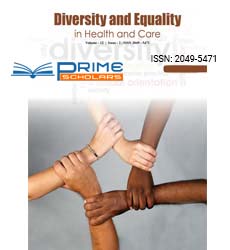Perspective - (2024) Volume 21, Issue 5
The Hidden Faces of Disadvantage: Exploring the Lives of Marginalized Groups
Lin Hui*
Department of Biological Science, Nanjing University, China
*Correspondence:
Lin Hui,
Department of Biological Science, Nanjing University,
China,
Email:
Received: 01-Oct-2024, Manuscript No. IPDEHC-24-21959;
Editor assigned: 03-Oct-2024, Pre QC No. IPDEHC-24-21959 (PQ);
Reviewed: 17-Oct-2024, QC No. IPDEHC-24-21959;
Revised: 22-Oct-2024, Manuscript No. IPDEHC-24-21959 (R);
Published:
29-Oct-2024, DOI: 10.35248/2049-5471-21.5.47
Introduction
Marginalized populations are groups that face systemic
disadvantages or exclusion from mainstream society due to
factors such as race, ethnicity, gender, sexual orientation,
disability, socioeconomic status, or immigration status.
These groups often experience limited access to resources,
opportunities, and services, and are subject to discrimination,
stigmatization, and social isolation. The concept of
marginalization goes beyond mere social or economic
inequality; it involves the active or passive processes that push
certain groups to the edges of society, rendering them invisible
or voiceless in crucial social, political, and economic discussions.
One of the key challenges marginalized populations face is the
lack of access to quality healthcare.
Description
Economic barriers, lack of health insurance, geographic
isolation, and cultural or language differences often prevent
these groups from receiving timely and adequate care. For
instance, people living in low-income communities, particularly
in rural or underserved urban areas, may not have access to wellequipped
healthcare facilities or professionals. Additionally,
marginalized racial and ethnic groups, such as Black, Indigenous,
and Latino populations, often encounter healthcare disparities
that stem from both historical and ongoing systemic racism.
These groups are more likely to suffer from chronic illnesses,
have lower life expectancy rates, and experience higher levels
of discrimination when seeking medical care. Another critical
aspect of marginalization is its impact on education and
employment. Individuals from marginalized communities often
face lower educational attainment, fewer job opportunities,
and unequal treatment in the workplace. Discrimination
based on race, gender, sexual orientation, or disability can
create barriers to professional advancement and job security.
For instance, women, especially women of color, frequently
encounter a “glass ceiling” in the workplace, limiting their
ability to rise to higher positions. Similarly, LGBTQ+ individuals
may experience harassment or bias, leading to higher rates
of job insecurity and lower wages. People with disabilities
may struggle to find meaningful employment, often due to
prejudices about their capabilities and a lack of accessible
workplaces. Social exclusion is another profound issue faced by
marginalized groups. When people are pushed to the margins
of society, they often lose the ability to participate fully in civic
and community life. This lack of participation can perpetuate
cycles of poverty, disempowerment, and isolation. For example,
undocumented immigrants often live in fear of deportation,
which restricts their ability to access public services, including
healthcare, education, and legal protection. Similarly,
individuals with mental health conditions or disabilities may
experience stigma that isolates them from mainstream society,
limiting their social interactions and further entrenching their
marginalized status.
Conclusion
A person who belongs to multiple marginalized groups may
face a unique set of challenges that are not easily addressed
by policies or interventions designed for a single group. For
example, a Black woman with a disability may experience
discrimination not only on the basis of race and gender but also
due to her disability, creating a compounded form of exclusion
and inequality. Understanding intersectionality is crucial for
developing solutions that effectively address the diverse needs
of marginalized individuals and communities.
Acknowledgement
None.
Conflict Of Interest
The author’s declared that they have no conflict of interest.
Citation: Hui L (2024) The Hidden Faces of Disadvantage: Exploring the Lives of Marginalized Groups. Divers Equal Health Care. 21:47.
Copyright: © 2024 Hui L. This is an open-access article distributed under the terms of the Creative Commons Attribution License, which permits unrestricted use, distribution, and reproduction in any medium, provided the original author and source are credited.

